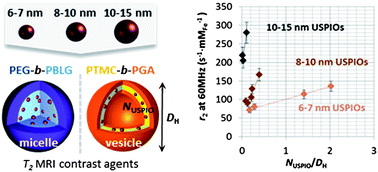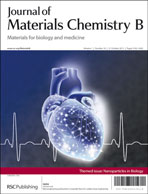Magnetic resonance imaging (MRI) is at the forefront of non-invasive medical imaging techniques. It provides good spatial and temporal resolution that can be further improved by the use of contrast agents (CAs), providing a valuable tool for diagnostic purposes. Ultrasmall superparamagnetic iron oxide (USPIO) nanoparticles are attractive MRI contrast agents due to their negative (T2) contrast enhancement capability and biocompatibility. Clusters of USPIOs with polymer material are of particular interest since they can sustain additional functionalities like drug delivery and targeting. Aiming to establish a relationship between the morphology of the clusters and their efficacy as MRI contrast agents (relaxometric properties), we prepared – using three different maghemite (γ-Fe2O3) USPIO diameters – a series of hybrid copolymer/iron oxide CAs presenting two different geometries (micellar or vesicular). The NMR relaxometry profiles confirmed the nature of the physical mechanisms inducing the increase of nuclear relaxation rates at low (magnetic anisotropy) and high (Curie relaxation) magnetic fields. A heuristic model, first proposed by Roch, Muller, Gillis, and Brooks, allowed the fitting of the whole longitudinal relaxivity r1(ν) profile, for samples with different magnetic core sizes. We show that both types of clusters exhibit transverse relaxivity (r2) values comparable to or higher than those of common contrast agents, over the whole tested frequency range. Moreover, in-depth analysis revealed substantially a linear relationship between r2 and the number of encapsulated USPIOs divided by the diameter of the clusters (NUSPIO/DH), for each USPIO size. The cluster structure (i.e. micelle or vesicle) appeared to have a mild influence on the transverse relaxivity value. Indeed, the r2 value was mainly governed by the individual size of the USPIOs, correlated with both the cluster external diameter and the magnetic material volume fraction.

You have access to this article
 Please wait while we load your content...
Something went wrong. Try again?
Please wait while we load your content...
Something went wrong. Try again?


 Please wait while we load your content...
Please wait while we load your content...